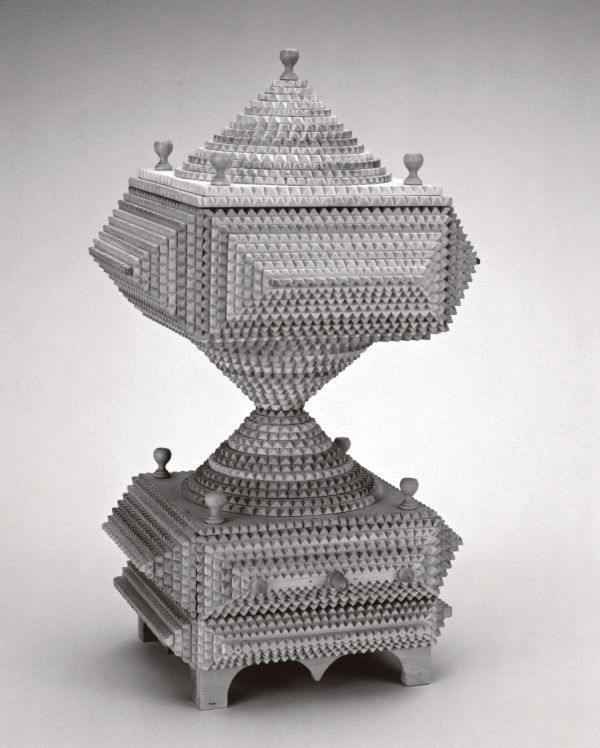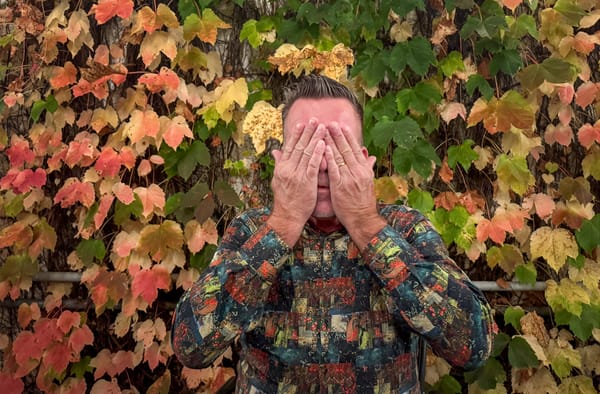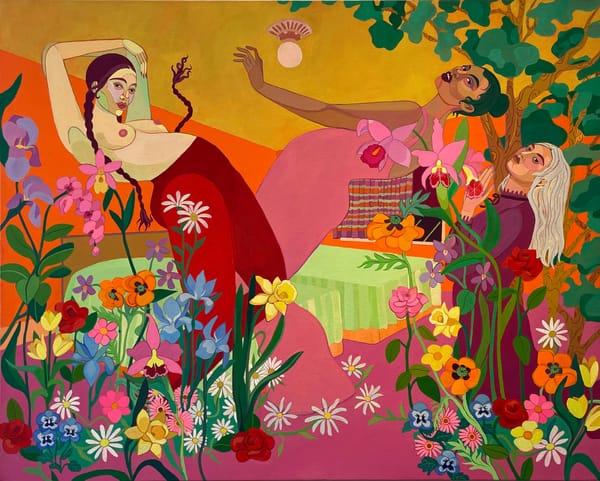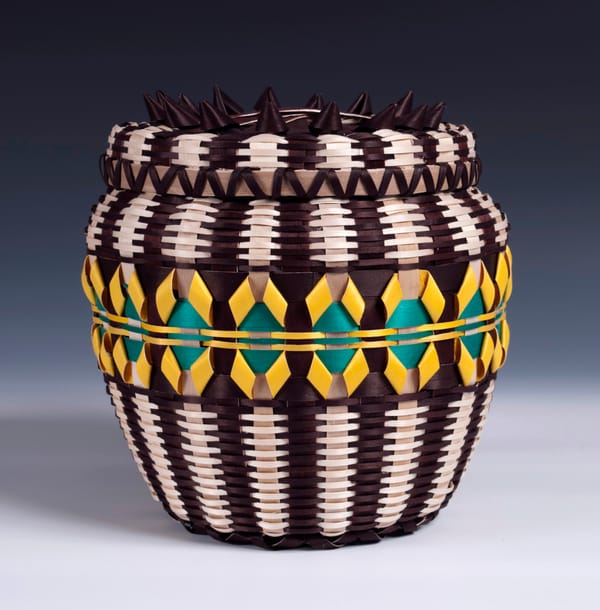Road Trip SHEBOYGAN: "Good Road to Follow"
by Carol Emmons
This exhibition at the John Michael Kohler Arts Center includes works known as “tramp art” from the Adolph Vandertie collection, along with photographs by David Eberhardt.
Some people see the art museum as an elitist institution featuring work by a small cadre of insiders. And it is true that there are far more working artists than those represented in such institutions. Further, there are clearly groups like women and artists of color who have been traditionally excluded and/or underrepresented.
However, the notion that museums are entirely blind to work except conventional “high art” is no longer wholly the case. In fact, many institutions have embraced ongoing redefinitions of the art museum. At one extreme are examples like the controversial 1998 Guggenheim “The Art of the Motorcycle” exhibit sponsored by BMW.* A different case is the Baltimore Museum of Art’s announcement that in 2020 it would buy only work by women artists “to rectify centuries of imbalance.” Yet another path is the establishment of art institutions focused on work by “outsiders” such as the American Visionary Art Museum, also in Baltimore.
A middle ground may be found in our own back yard, at the John Michael Kohler Arts Center (Sheboygan). The Kohler has established an international reputation for working across standard categories. Since its inception in 1967, offerings have included contemporary art, works in what had been typed “craft “media, applied arts, folk art, and performing arts by both professional and community artists. Shepherded by Ruth Kohler, this programming expanded to include a special commitment to the work of self-taught artists, culminating in the August 2020 premiere of the “Art Preserve” which will house artist-built environments.
While many museums in smaller communities combined displays of local history, crafts, and art, what set the Kohler apart was overarching thematic concerns and the inclusion of challenging contemporary work. Thus an exhibit like “Remains to be Seen” (1983) surveyed 200 works in bone, ivory, horn and antler, ranging from Paleolithic to contemporary, and representing makers of diverse ethnographies and the self-taught. Such projects did not fall victim to the patronizing condescension often seen elsewhere, and as the years went by, they engaged more rigorous concerns of context and content.
Thus for the current “Good Road to Follow” exhibit, the Center has created a suggestion of Adolph Vandertie’s home (small windowed rooms with siding on the exterior) which originally housed his museum. Vandertie (1911-2007) was born in Lena, Wisconsin and spent much of his life in Green Bay. He related that as a youngster he spent time in local hobo camps: eating Mulligan stew, hearing stories, and being captivated by the hobos’ whittling. He later took to the rails, exploring the hobo life until age 21, when he married and settled down in Green Bay.
In the 1940s he began carving again, eventually creating thousands of pieces, as well as collecting similar works by others. The Kohler acquired about 1300 of these specimens in 2001; much of the remainder is housed at the Ashwaubenon Historical Society Museum (Green Bay).

In his “Hobo & Tramp Art Carving” book, Vandertie says hobos were laboring men with many skills who wandered in search of work. He describes their carvings as whimsical, used for barter or gifts. Among the classic forms are the ball-in-the-cage—a free-floating sphere restrained in an open cage carved from a single block or stick. Another popular form was the chain, again carved to liberate links from a single piece of wood using a pocket knife.
Vandertie discriminates between hobos and tramps, claiming the latter were also wanderers enabled by the availability of trains after the industrial revolution, but that they lived instead by their wits or through begging or thievery. Their carvings were distinguished by chip-carved cigar boxes—widely available as revenue laws did not permit reusing the boxes for cigars. The process entailed repeated notching of layers, each decreasing in size so that when assembled a rich geometric pattern emerged. Tramp art could also include applied or inlaid decorations and were often utilitarian: boxes, picture frames, or chests. The works on display range in size and technique but generally follow this typography.
In his book, Vandertie writes that “…teenage boys dreamed of becoming hoboes” (14) and goes on to say “[t]he hoboes lived by their own code of law and honor, authored their own stories, composed their own songs, developed their own customs, and wrote their own language. They were members of a new society…”(16) These statements reveal both his love of hobo culture and a romanticization of it.
The Spring 2020 Kohler magazine gently notes that while Vandertie was “undeniably a master carver and a significant contributor to the understanding of hobo and tramp art as a historic art form…the world of the hobo that Vandertie promoted and believed in was only one man’s idealized version of that way of life.” (12) This statement indicates progress toward a less simplistic notion of the self-taught artist. **
In this case, “Good Road to Follow” (the title borrowed from a traditional hobo sign) is complemented by the black-and-white photographs of David Eberhardt, documents from his “riding the rails” for over a decade and 30,000 miles. Screened in the neighboring gallery, Bill Daniel’s film “Who is Bozo Texino?” entailed over 16 years of work recording train graffiti and people he met along the way. Both these projects serve to balance the clean and tidy Vandertie environment within the larger realities of hobo and tramp life. The casual black and white nature of both bodies of work encourages reading them as documents of reality. While such a “snapshot aesthetic” is equally subject to sentimentalizing, the gritty quality of these images creates a more balanced semblance of life on the rails.

Self-taught artists and their production have not only been romanticized but seriously commodified. Despite widely varied motivations, such people are often typed as “weird” or “crazy” or relegated to other categories outside the norm. This both marginalizes them and enfeebles them, denying their own agency. However, the more nuanced and respectful view provided by the programming at the Kohler Arts Center serves both the makers and the audience, developing an appreciation not only for the technical skill and aesthetic vision on display, but lending a sense of the environment and social conditions surrounding the work. This in turn humanizes and deepens our appreciation of all artists and the artistic endeavor itself.
* see Jacob Weisberg “Exhibiting Contempt: Populism vs. democracy at the art museum” in Slate 9.6.1998: https://slate.com/technology/1998/09/exhibiting-contempt.html
** see Joanne Cubbs “Rebels, Mystics, and Outcasts: The Romantic Artist Outsider” in The Artist Outsider: Creativity and the Boundaries of Culture ed. Michael D. Hall & Eugene W. Metcalf, Jr. (Smithsonian Press, 1994) pp. 76 – 93 (Cubbs is a former Kohler curator)
- Ashwaubenon Historical Society Museum: www.ashhs.com/
- Adolph Vandertie & Patrick Spielman, Hobo & Tramp Art Carving: An Authentic American Folk Tradition (NY: Sterling 1995)
- Jim Rivett, director: Westbound: A Documentary (2011) 77 minutes (a film about Vandertie)
- Nicholas Eggert, “Honoring the Grand Duke of Hobos at the Ashwaubenon Historical Society” Voyageur Magazine Summer/Fall 2018 (vol 35/no 1), pp. 12-13
Carol Emmons is an installation artist and Professor Emerita of Art at the University of Wisconsin-Green Bay.



